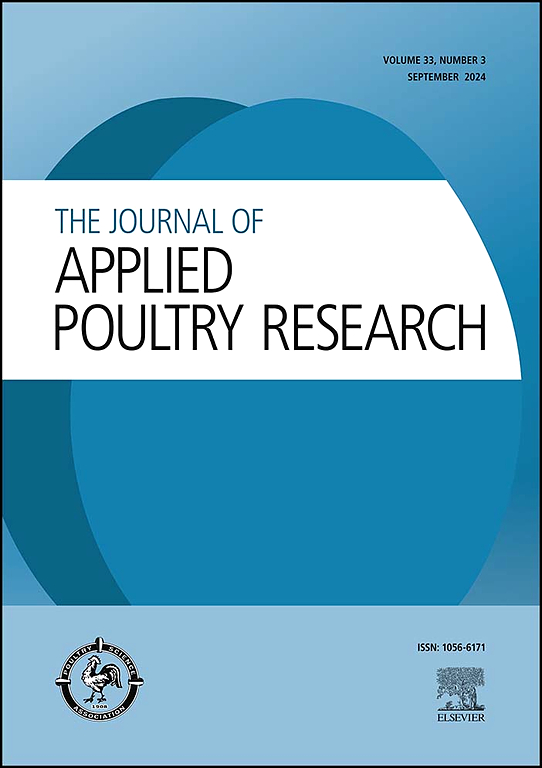The effects of excess non-phytate phosphorus from dicalcium phosphate or phytase supplementary sources on performance in laying hens fed reduced-protein diets
IF 2
3区 农林科学
Q2 AGRICULTURE, DAIRY & ANIMAL SCIENCE
引用次数: 0
Abstract
The rapid growth of industrial egg production has intensified environmental and economic pressures, prompting the adoption of reduced crude protein (CP) diets supplemented with amino acids to lower costs and nitrogen waste. However, CP reduction may limit phosphorus availability, potentially impairing energy metabolism. This study investigates whether adding extra non-phytate phosphorus (NPP) from mineral (dicalcium phosphate, DCP) and enzymatic (phytase) sources can improve performance, nutrient use, and egg quality in hens fed reduced-CP diets. A total of 528 Hy-Line W36 hens (50 weeks old) were used in a 2 × 5 + 1 factorial design. The CP levels included 14 % and 15 % (2 % and 1 % below the recommended level), and excess NPP treatments consisted of: no additional NPP (recommended NPP level), 1 and 2 g/kg extra NPP via added DCP, and 1.6 and 2 g/kg extra NPP via phytase supplementation (250 and 500 FYT/kg). A control diet containing 16 % CP (recommended CP level) was included as the eleventh treatment. Key findings showed phytase at 250–500 FYT/kg significantly improved egg production, egg mass, and feed conversion ratio compared to unsupplemented diets. Notably, 500 FYT/kg phytase enhanced digestibility of gross energy, CP, ether extract, and calcium, whereas inclusion of NPP from DCP reduced calcium digestibility. Interactive effects between CP and excess NPP were observed: 500 FYT/kg phytase in 15 % CP diets improved P digestibility and eggshell strength, while both phytase levels increased eggshell thickness. In conclusion, phytase supplementation improved laying hen performance in reduced-CP diets through extra-phosphoric effects, while excess NPP from DCP was ineffective.
磷酸二钙和植酸酶补充源中过量非植酸磷对低蛋白质饲粮蛋鸡生产性能的影响
工业化蛋品生产的快速增长加剧了环境和经济压力,促使采用添加氨基酸的低粗蛋白质饲粮,以降低成本和氮浪费。然而,CP的减少可能会限制磷的有效性,潜在地损害能量代谢。本研究旨在探讨在低cp饲粮中额外添加矿物质(磷酸二钙)和酶(植酸酶)来源的非植酸磷(NPP)是否能提高母鸡的生产性能、营养物质利用和蛋品质。试验采用2 × 5 + 1因子设计,共选用528只50周龄的海兰W36母鸡。CP水平分别为14%和15%(比推荐水平低2%和1%),过量NPP处理包括:不增加NPP(推荐NPP水平),通过添加DCP增加1和2 g/kg的NPP,通过添加植酸酶(250和500 FYT/kg)增加1.6和2 g/kg的NPP。第11个处理为含16%粗蛋白质(推荐粗蛋白质水平)的对照饲粮。主要研究结果表明,与未添加植酸酶的饲粮相比,添加250-500 FYT/kg植酸酶显著提高了蛋产量、蛋质量和饲料系数。值得注意的是,500 FYT/kg植酸酶提高了总能、粗蛋白质、粗脂肪和钙的消化率,而DCP中添加NPP降低了钙的消化率。CP与过量NPP之间存在交互效应:15% CP饲粮中添加500 FYT/kg植酸酶可提高磷消化率和蛋壳强度,两种植酸酶水平均可增加蛋壳厚度。综上所述,在低cp饲粮中,添加植酸酶通过额外的磷效应提高了蛋鸡生产性能,而DCP产生的过量NPP无效。
本文章由计算机程序翻译,如有差异,请以英文原文为准。
求助全文
约1分钟内获得全文
求助全文
来源期刊

Journal of Applied Poultry Research
农林科学-奶制品与动物科学
CiteScore
4.10
自引率
10.50%
发文量
80
审稿时长
104 days
期刊介绍:
The Journal of Applied Poultry Research (JAPR) publishes original research reports, field reports, and reviews on breeding, hatching, health and disease, layer management, meat bird processing and products, meat bird management, microbiology, food safety, nutrition, environment, sanitation, welfare, and economics. As of January 2020, JAPR will become an Open Access journal with no subscription charges, meaning authors who publish here can make their research immediately, permanently, and freely accessible worldwide while retaining copyright to their work. Papers submitted for publication after October 1, 2019 will be published as Open Access papers.
The readers of JAPR are in education, extension, industry, and government, including research, teaching, administration, veterinary medicine, management, production, quality assurance, product development, and technical services. Nutritionists, breeder flock supervisors, production managers, microbiologists, laboratory personnel, food safety and sanitation managers, poultry processing managers, feed manufacturers, and egg producers use JAPR to keep up with current applied poultry research.
 求助内容:
求助内容: 应助结果提醒方式:
应助结果提醒方式:


